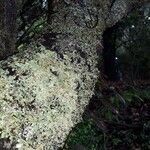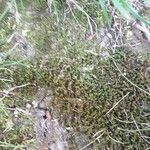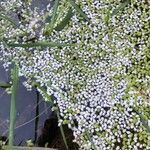Roots to 1.5 cm, tip rounded to pointed; sheath not winged. Stipes white, small, often decaying. Fronds floating, 1 or 2--few, coherent in groups, obovate, flat to thickish (but not gibbous), 0.8--4 mm, 1--2 times as long as wide, margins entire; veins 1, sometimes indistinct, very rarely longer than extension of air spaces, not longer than 2/3 of distance between node and apex; with or without small papillae along midline; anthocyanin absent; largest air spaces much shorter than 0.3 mm; turions absent. Flowers: ovaries 1-ovulate, utricular scale open on 1 side. Fruits 0.6--1 mm, not winged. Seeds with 12--15 distinct ribs. 2n = 36 (U), 40 (U), 42 (G).
Thallus flat or nearly so on both sides, thin-margined, smooth or with a few low papillae along the midline above, ovate to elliptic, symmetrical or nearly so, solitary or sometimes 2(+) together, not anthocyanic, 1–2.5 mm, mostly 3/5 to fully as wide, the single obscure nerve reaching at most 2/3 of the way from node to apex; spathe open; fr exserted, elongate, tapering to the persistent terminal style; seed solitary, elongate, evidently ribbed; 2n=36, 40. Mainly w. U.S. and temp. S. Amer., perhaps not in our range. (L. minima; L. minuscula)




